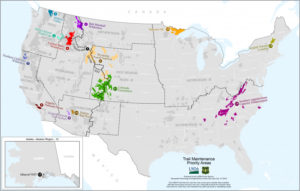By Partnership for the National Trails System
Adapted from USDA and U.S. Forest Service news releases, websites, and publications
The U.S. Forest Service (USFS) incorporates several standardized trail management concepts and tools in the administration and management of over 150,000 miles of National Forest System trails. These tools help ensure that each trail is designed, constructed, and maintained to provide the desired user experience and meet the management intent for the trail.
PRIORITY AREAS
The U.S. Department of Agriculture (USDA) recently selected 15 Trail Maintenance Priority Areas to help address the more than $300 million trail maintenance backlog on national forests and grasslands. Focused trail work in these areas, bolstered by partners and volunteers, is expected to help address needed infrastructure work so that trails managed by the USFS can be accessed and safely enjoyed by a wide variety of trails enthusiasts. About 25 percent of agency trails fit those standards while the condition of other trails lag behind.
The announcement was made to national trails partners in February during Hike the Hill. Among the trails that meet the requirements of the National Forest System Trails Stewardship Act of 2016 and are included in the trail maintenance priority areas are:
- Continental Divide National Scenic Trail
- Iditarod National Historic Trail
- Pacific Crest National Scenic Trail
- Pacific Northwest National Scenic Trail
STRATEGY
In October 2017, the USDA published the “National Strategy for a Sustainable Trail System,” which has been sent to USFS offices and national trail partners. This strategy establishes a bold vision for a sustainable trail system achieved through collaborative stewardship. It identifies core values to guide implementation and outlines a series of strategic actions to leverage critical investments in agency and partner leader intent and resources toward achieving a 10-year action plan.
In achieving a sustainable trail system, the USFS faces six areas that require action: leader intent, organization and talent, relevancy, sustainable systems, agency processes and culture, and information. Each of these can be scaled and adapted to inspire change at all levels of the agency, as well as with partners, volunteers, and friends.
GUIDEBOOK
The USDA and Federal Highway Administration (FHWA) also published an updated version of the “Trail Fundamentals and Trail Management Objectives” guidebook. Trail Fundamentals include five key concepts that are cornerstones of USFS trail management: trail type, trail class, managed use, designed use, and trail design parameters.
Full list of trail maintenance priority areas: www.fs.fed.us/news/releases/usda-secretary-announces-infrastructure-improvements-forest-system-trails
Additional trail management tools: www.fs.fed.us/recreation/programs/trail-management/index.shtml
Unless otherwise indicated, all material in Pathways Across America is public domain. All views expressed herein are perspectives of individuals working on behalf of the National Trails System and do not necessarily represent the viewpoint of the Federal agencies.
